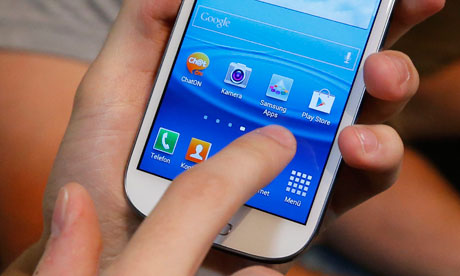
Designing well for mobiles should force businesses to ruthlessly prioritise information and functionality. Photograph: Fabrizio Bensch/Reuters
A couple of months ago Karen McGrane posted Mobile > Local, a frustrated essay at the way that designers and businesses consistently conflate the two ideas. "Just because someone is doing a search from amobile device doesn't make it a local search. And just because someone is looking for local content doesn't imply they're using a mobile device," she wrote.
McGrane's frustration is one that I share when approaching design for smaller screens. Just because a user might be running for the bus when using the mobile version of a site, doesn't mean they won't ever simply be sitting on the sofa using their phone.
In the comments under McGrane's blog, Simon Unger perfectly illustrates the problem of making assumptions about people's intentions based on the device they are using. "Imdb.com has been around for at least a decade and its interface has changed only a little and gradually over that time," he wrote. "On my desktop I can find information I want easily and without thinking.
"However, on Friday night I'm at the pub or in the video store, I pull out my phone to settle an argument, browse to imdb. First, I get told to download the app, I'm in a hurry and only on 3G, so I click my [way] out of it. Then, rather than information being where I expect it to be, I'm greeted with a new interface that I have to try an learn on the spot. By simplifying the experience it's actually made life harder and more frustrating."
Last year I saw a presentation by Amy Buckner and Pamela Walshe at the UPA conference in Atlanta, where they talked about a research project carried out by Wells Fargo. The bank had assumed that everybody using their mobile banking application was young, tech-savvy and, well ... mobile. Their diary study asked people to take a picture with their phone every time they used the mobile banking site, and when the research team saw the pictures, it was a revelation.
Not only were many people using the mobile version outside the expected age range, but what they could see in a lot of the pictures surprised them. Often there was a desktop computer in view. These weren't people being forced to use the mobile service because they didn't have access to a main computer – these were people using what was convenient to them and already at hand.
McGrane's proposal is that we should stop putting all our design energy into solving how to do whizzy features that assume any person on a small device is looking for local timely information, and re-double our efforts to get the vast majority of web content working well on mobiles.
Darin Wonn disagrees – his essay on situational awareness had been one of the triggers for McGrane to write her essay. "It feels like desktop websites have 15 years of accumulated features and band-aids. So, why spend the next three to five years cleaning up everything that is wrong with desktop content?" he asked in the comments on McGrane's post. "Let's figure out what we need for mobile and start fresh. Let's work outward from the needs of mobile users.
"If you are working at a large organisation, it can be impossible to move the needle on a 15-year desktop site, but you have the opportunity to plant the seeds for something that is responsive and future-proof if you start with mobile."
Designing well for mobiles is tough. You have all the potential usage cases of the desktop environment, plus some extra ones, and not very many pixels to fit everything into. But I think a good designer should relish the challenge. It really should force businesses to ruthlessly prioritise the information and functionality that they want to present and build for the user.
Comments